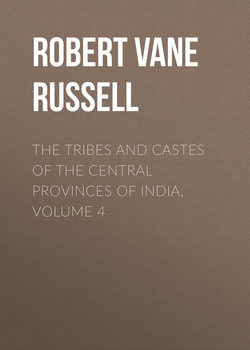Читать книгу The Tribes and Castes of the Central Provinces of India, Volume 4 - Robert Vane Russell - Страница 29
Part II
Articles on Castes and Tribes
Kumhār—Yemkala
Vol. IV
Kunbi
16. Religion
ОглавлениеThe principal deities of the caste are Māroti or Hanumān, Mahādeo or Siva, Devi, Satwai and Khandoba. Māroti is worshipped principally on Saturdays, so that he may counteract the evil influences exercised by the planet Saturn on that day. When a new village is founded Māroti must first be brought and placed in the village and worshipped, and after this houses are built. The name Māroti is derived from Marut, the Vedic god of the wind, and he is considered to be the son of Vāyu, the wind, and Anjini. Khandoba is an incarnation of Siva as a warrior, and is the favourite deity of the Marāthas. Devi is usually venerated in her Incarnation of Marhai Māta, the goddess of smallpox and cholera—the most dreaded scourges of the Hindu villager. They offer goats and fowls to Marhai Devi, cutting the throat of the animal and letting its blood drop over the stone, which represents the goddess; after this they cut off a leg and hang it to the tree above her shrine, and eat the remainder. Sometimes also they offer wooden images of human beings, which are buried before the shrine of the goddess and are obviously substitutes for a human sacrifice; and the lower castes offer pigs. If a man dies of snake-bite they make a little silver image of a snake, and then kill a real snake, and make a platform outside the village and place the image on it, which is afterwards regularly worshipped as Nāgoba Deo. They may perhaps think that the spirit of the snake which is killed passes into the silver image. Somebody afterwards steals the image, but this does not matter. Similarly if a man is killed by a tiger he is deified and worshipped as Bāghoba Deo, though they cannot kill a tiger as a preliminary. The Kunbis make images of their ancestors in silver or brass, and keep them in a basket with their other household deities. But when these get too numerous they take them on a pilgrimage to some sacred river and deposit them in it. A man who has lost both parents will invite some man and woman on Akshaya Tritiya,35 and call them by the names of his parents, and give them a feast. Among the mythological stories known to the caste is one of some interest, explaining how the dark spots came on the face of the moon. They say that once all the gods were going to a dinner-party, each riding on his favourite animal or vāhan (conveyance). But the vāhan of Ganpati, the fat god with the head of an elephant, was a rat, and the rat naturally could not go as fast as the other animals, and as it was very far from being up to Ganpati’s weight, it tripped and fell, and Ganpati came off. The moon was looking on, and laughed so much that Ganpati was enraged, and cursed it, saying, ‘Thy face shall be black for laughing at me.’ Accordingly the moon turned quite black; but the other gods interfered, and said that the curse was too hard, so Ganpati agreed that only a part of the moon’s face should be blackened in revenge for the insult. This happened on the fourth day of the bright fortnight of Bhādon (September), and on that day it is said that nobody should look at the moon, as if he does, his reputation will probably be lowered by some false charge or libel being promulgated against him. As already stated, the Kunbi firmly believes in the influence exercised by spirits, and a proverb has it, ‘Brāhmans die of indigestion, Sunārs from bile, and Kunbis from ghosts’; because the Brāhman is always feasted as an act of charity and given the best food, so that he over-eats himself, while the Sunār gets bilious from sitting all day before a furnace. When somebody falls ill his family get a Brāhman’s cast-off sacred thread, and folding it to hold a little lamp, will wave this to and fro. If it moves in a straight line they say that the patient is possessed by a spirit, but if in a circle that his illness is due to natural causes. In the former case they promise an offering to the spirit to induce it to depart from the patient. The Brāhmans, it is said, try to prevent the Kunbis from getting hold of their sacred threads, because they think that by waving the lamp in them, all the virtue which they have obtained by their repetitions of the Gāyatri or sacred prayer is transferred to the sick Kunbi. They therefore tear up their cast-off threads or sew them into clothes.
35
The 3rd Baisākh (May) Sudi, the commencement of the agricultural year. The name means, ‘The day of immortality.’
